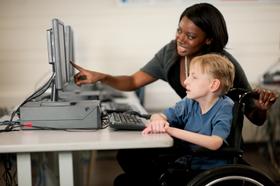Serving 593 students in grades 6-8, Big Spring Middle School ranks in the top 50% of all schools in Pennsylvania for overall test scores (math proficiency is bottom 50%, and reading proficiency is bottom 50%).
The percentage of students achieving proficiency in math is 32% (which is lower than the Pennsylvania state average of 36%). The percentage of students achieving proficiency in reading/language arts is 65% (which is higher than the Pennsylvania state average of 55%).
The student:teacher ratio of 13:1 is equal to the Pennsylvania state level of 13:1.
Minority enrollment is 7% of the student body (majority Hispanic and Black), which is lower than the Pennsylvania state average of 38% (majority Black).
Quick Stats (2024-25)
- School Type: Magnet School
- Grades: 6-8
- Enrollment: 593 students
- Student:Teacher Ratio: 13:1
- Minority Enrollment: 7%
- Overall Testing Rank: Top 50% in PA
- Math Proficiency: 32% (Btm 50%)
- Reading Proficiency: 65% (Top 50%)
- Science Proficiency: 65-69% (Top 50%)
- Source: National Center for Education Statistics (NCES), PA Dept. of Education
School Overview
Big Spring Middle School's student population of 593 students has stayed relatively flat over five school years.
The teacher population of 44 teachers has declined by 8% over five school years.
School Type
Grades Offered
Grades 6-8
(offers virtual instruction)
(offers virtual instruction)
Total Students
593 students

Gender %

Total Classroom Teachers
44 teachers

Students by Grade

School Rankings
Big Spring Middle School ranks within the top 50% of all 2,733 schools in Pennsylvania (based off of combined math and reading proficiency testing data).
The diversity score of Big Spring Middle School is 0.13, which is less than the diversity score at state average of 0.58. The school's diversity has stayed relatively flat over five school years.
Overall Testing Rank
#1282 out of 2733 schools
(Top 50%)
(Top 50%)

Math Test Scores (% Proficient)
32%
36%

Reading/Language Arts Test Scores (% Proficient)
65%
55%

Science Test Scores (% Proficient)
65-69%
57%

Student : Teacher Ratio
13:1
13:1

American Indian
n/a
n/a
Asian
1%
5%

Hispanic
2%
14%

Black
1%
14%

White
93%
62%

Hawaiian
n/a
n/a
Two or more races
3%
5%

All Ethnic Groups



Eligible for Free Lunch
41%
54%

Eligible for Reduced Lunch
3%
2%

School Statewide Testing
School District Name
Source: National Center for Education Statistics (NCES), PA Dept. of Education
Frequently Asked Questions
What is Big Spring Middle School's ranking?
Big Spring Middle School is ranked #1282 out of 2,733 schools, which ranks it among the top 50% of public schools in Pennsylvania.
What percent of students have achieved state testing proficiency in math and reading?
32% of students have achieved math proficiency (compared to the 36% PA state average), while 65% of students have achieved reading proficiency (compared to the 55% PA state average).
How many students attend Big Spring Middle School?
593 students attend Big Spring Middle School.
What is the racial composition of the student body?
93% of Big Spring Middle School students are White, 3% of students are Two or more races, 2% of students are Hispanic, 1% of students are Asian, and 1% of students are Black.
What is the student:teacher ratio of Big Spring Middle School?
Big Spring Middle School has a student ration of 13:1, which is equal to the Pennsylvania state average of 13:1.
What grades does Big Spring Middle School offer ?
Big Spring Middle School offers enrollment in grades 6-8 (offers virtual instruction).
What school district is Big Spring Middle School part of?
Big Spring Middle School is part of Big Spring School District.
School Reviews
5 10/27/2014
I love middle school! We have lots of sports and arts programs to choose from including: band,chorus,field hockey,track and football.The subjects include Science,Math,Social Studies and Language Arts. The teachers are nice and helpful. The school is quite large but not very hard to navaigate through.
Review Big Spring Middle School. Reviews should be a few sentences in length. Please include any comments on:
- Quality of academic programs, teachers, and facilities
- Availability of music, art, sports and other extracurricular activities
Recent Articles

How Does Bullying Affect a Student’s Academic Performance?
We explore the significant impact of bullying on students' academic performance, discussing statistics, research findings, and long-term effects. It provides valuable insights for educators and parents on recognizing bullying behaviors and implementing effective prevention strategies to create a safe learning environment.

Can Students Be Legally Prosecuted for School Fights?
This comprehensive guide explores the increasing trend of legal prosecution for school fights, discussing recent incidents, age considerations, and the shift from traditional school punishments to law enforcement involvement. It provides valuable insights for parents, educators, and students about the evolving landscape of school discipline and safety measures.

Understanding Rubrics
This article explores the fundamental principles of rubrics in education, focusing on their role as assessment tools. It breaks down the key components of rubrics, including criteria, performance levels, and descriptors. The piece also delves into the two main types of rubrics - holistic and analytic - providing authoritative definitions and explaining their unique applications in educational settings.









